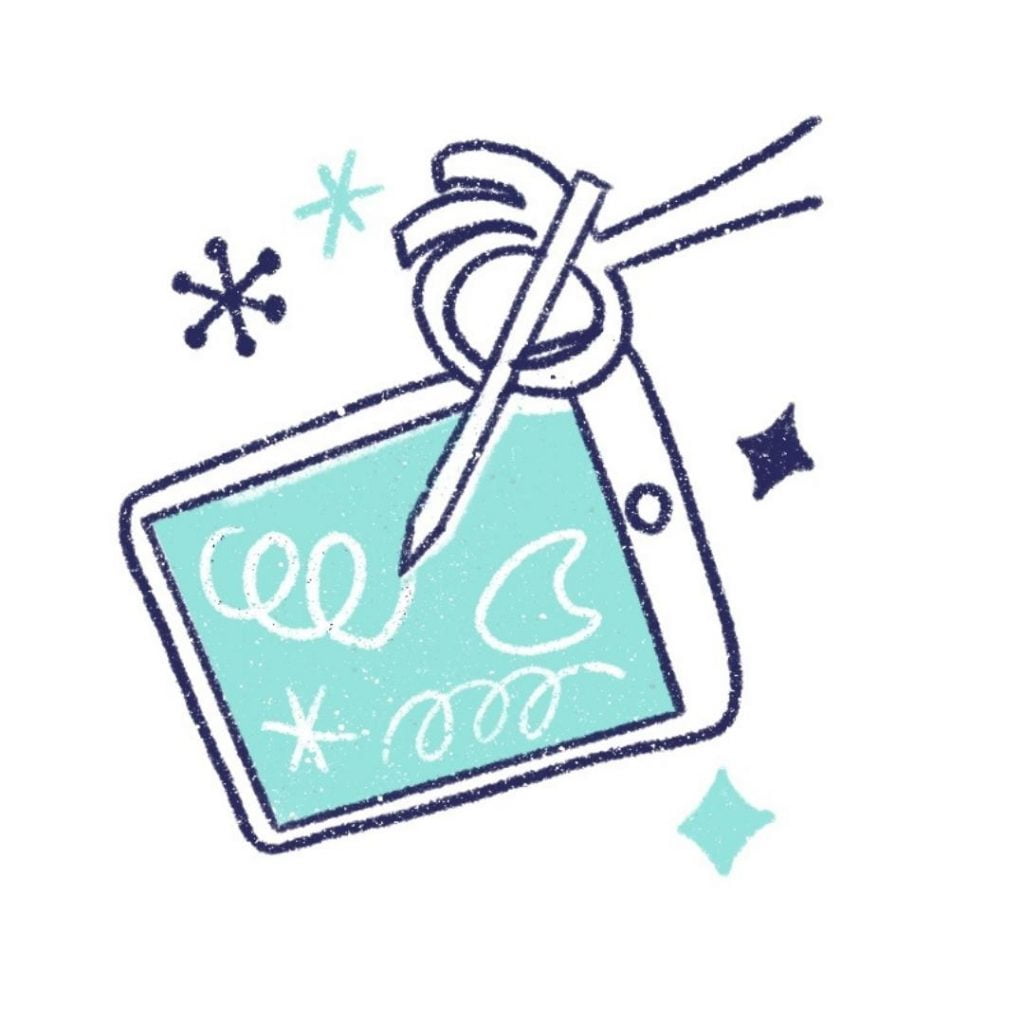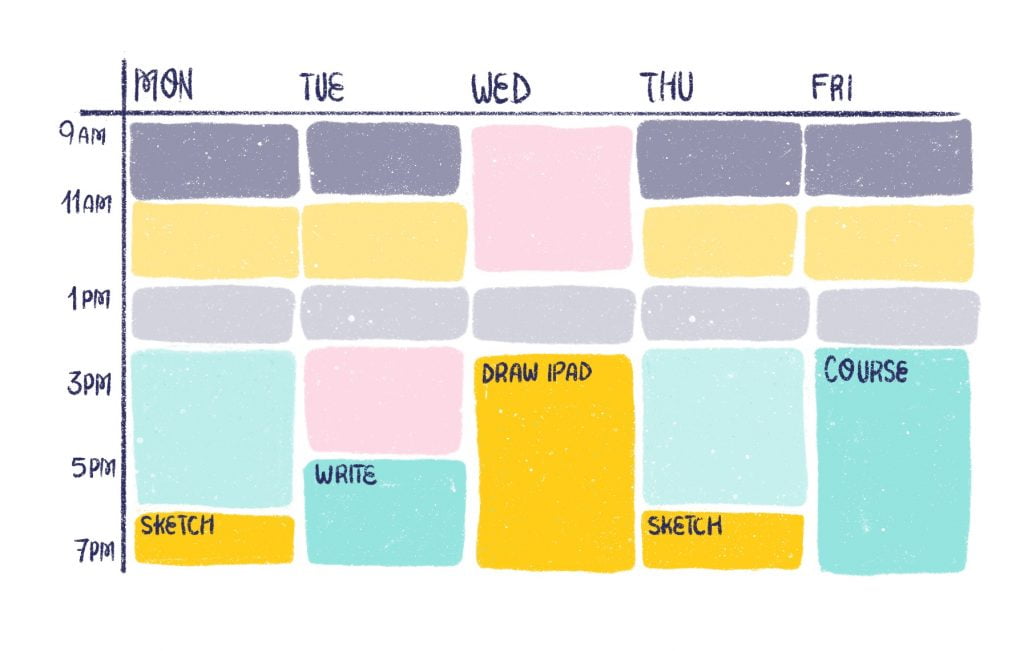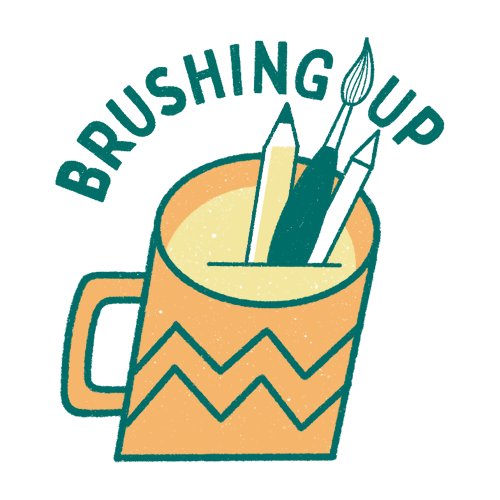When I started freelance illustrating, I was overwhelmed with all the things I needed to do. There was just no time to actually figure out what I wanted to create and have fun. And these moments of creation, purely for yourself or to develop your style, are important, because you can make the most progress creatively and find your best ideas. For me, those creative sessions give me clarity, and remind of why I’m on this path. But, unfortunately, it can be difficult to find the time.

The best way to make time for these moments is to turn creating into a habit. This way, we’ll make it easier for ourselves to do. So whether you have a dayjob and are looking for ways to find time to create on the side, or are a fulltime illustrator; here’s how to develop creative habits in 4 steps.
These moments of creation, purely for yourself or to develop your style, are important, because you can make the most progress creatively and find your best ideas.
Habits are a routine or behaviour which we perform regularly, automatically even. Your brain will turn anything you do regularly into habit. It is an action that is easier to do, there’s less decisions to make and simply happens automatic, without having to think too much about it (drinking 8 glasses of water a day, walk 30 minutes a day, read daily, for example).

So how do we develop a creative habit? How can we make sure our brain will do something almost automatically? The author James Clear explains his system for creating habits in his book ‘Atomic habits’:
‘The Four Laws of Behavior Change are a simple set of rules we can use to build better habits. They are (1) make it obvious, (2) make it attractive, (3) make it easy, and (4) make it satisfying.‘
If you want to read more about how this works; here’s a bit more about habits: How To Start New Habits That Actually Stick. So, in order to change your behavior and create new habits, you have to ask yourself:
- How can I make it obvious?
- How can I make it attractive?
- How can I make it easy?
- How can I make it satisfying?
I’ll answer these questions with practical steps that have worked for me to make creative habits stick.
I’m refering to ‘creative sessions’ in this post a lot; this is the habit we’re creating. I like to use this time for sketching out ideas, writing, illustrating in Procreate and learning. But the techniques i’m refering to here can apply to anything creative; from editing videos, to knitting, to whatever you feel like.
1. Make It obvious: Time blocking
How can I make it obvious? Set aside regular time to make things. Schedule creative sessions with yourself, at a dedicated time and place. For example: ‘I will draw for 30 minutes a day, at 7 pm, at my desk’.
People often make the mistake of thinking you need to be in a ‘creative high’ or be motivated to make things. But often, motivation comes after you start, not before. So schedule ‘creating’ time, whether you’re feeling up for the task or not. Most likely you’ll find that, once you start, it’s easier to keep going. Use that time to make what comes to mind. Without expectations, or having to finish something.
Often, motivation comes after you start, not before
I do this by time blocking my calendar (I use Google Calendar) and schedule weekly creative sessions, at the same time. Time blocking means you divide your day into blocks of time. Each block is dedicated to accomplishing a specific task, or group of tasks. Instead of keeping a to-do list of things you’ll get to as you’re able, you’ll start each day with a schedule that lays out what you’ll work on and when. I do this for all my tasks. This helps creating on a weekly basis, without having to think too much about it.

Timeblocking, in general, is a good idea if you have a lot of tasks and a to-do list that often feels a bit endless. Blocking your time means you are setting realistic expectations for yourself, and stick to the thing that’s happening at that hour.
2. Make It attractive: Write down your best ideas
Alright, so time blocking is great if you actually have the time to do it. But some people work fulltime or have other stuff to do and can’t change their schedule around that much, so we need to find the time whenever we have a spare moment.
Innovative ideas and creativity can comes to us at different times. We’re not always prepared to start working on them right away. And when we do want to start a creative session (or finally have the time for it), we might go blank. So, how can we make it attractive to start? By having inspiration ready to go, in a sketchbook. Write down your best ideas as soon as you get them, and work on your ideas when you have the time. Use this sketchbook (physical or digital) as a braindump for your thoughts, ideas, or whatever comes to mind. This will help you to collect your best ideas and get back to them easily.

Innovative ideas and creativity can come to us at different times. We’re not always prepared to start working on them right away.
When I’m working on client projects, or editing videos, or writing emails, I don’t have time to just pick up a pen and start drawing all the ideas I have. As soon as they pop in my head, I write them down, maybe with a thumbnail sketch (whatever helps me visualize it best). I have a small sketchbook open on my desk at all times. When I’m out, I use Google Keep to write down ideas. When I have time for a creative session (or have it time blocked in my calendar), I already have a bunch of ideas. Use your most creative time to come up with the idea and use a creative session to develop it further.
Write down your best ideas as soon as you get them

For those who often have their best ideas at the gym or on a walk, you are not alone; exercise has been proven to inspire great ideas. During exercise, blood pressure and blood flow increase, boosting the flow of oxygen in the brain. When the brain has more oxygen, ideas flow more freely. So keep a sketchbook or your phone with you to get it out of your head and save it for your next session!
3. Make It Easy: Find your creative highs
If I’m forced to create and come up with new ideas in the morning; forget it. Not going to happen. I have the most energy later in the day, and feel most creative after lunch. Because of this, it makes most sense for me to do my creative work at that time. So, what we can we do to make our creative habit easy? By figuring out when we have the most energy and use that time for creating. We need to figure out when our brain is at its most creative and energetic.

For some of us, we find ourselves to be more creative at night, while others have more ideas and produce more and better work in the morning. Why? Because our bodies tend to work in strict cycles of ups and downs called biorhythms (or circadian rhythms). These rhythms regulate everything from blood pressure, body temperature, respiration rate, and, critically for creativity, energy levels.
I sometimes get creative boosts of energy from 5 to 10 pm. I dedicate that time to doing the work that takes me the most thinking time, and when I need to brainstorm. Mornings are a quiet time for me, reserved for household tasks, doing admin and projects that don’t require my brain as much (there’s plenty to do when you’re not in a creative mood or time of day: 3 Things to do when the creative juices aren’t flowing).
For some of us, we find ourselves to be more creative at night, while others have more ideas and produce more work in the morning.
Maybe your time to shine is post coffee, and pre-lunch. You can have your best ideas in that short period of time. It’s when you write best, when you enjoy sketching most, and when you can read for long periods of time without getting drowsy. Use post-lunch for production, work that doesn’t require as much thinking and other tasks. Discover when you feel most creative and do your best to embrace that in your schedule. Try to find the path of least resistance.
Sidenote: I have a ‘creative high’ somewhere between 5 to 10 pm. This doesn’t mean I am an explosive, creative ball of fire for 5 hours (Only sometimes, or unless I drink way too much coffee, don’t do that people!). The brain isn’t designed to focus for long periods of time. In fact, the mind can only focus for 90 to 120 minutes before needing a break. This length of time matches the 90-minute sleep cycles a person has each night, experts note. Sleep researcher Nathan Kleitman labeled this the ‘basic rest-activity cycle,’ noting that in wakefulness, humans also need 90 minutes of productivity before taking a break (Why Working in 90-Minute Intervals Is Powerful for Your Body and Job).
The first step to identifying your rhythms is to take what’s referred to as a ‘Morningness–Eveningness questionnaire.’ If you’re not sure when your brain has the most energy; this quiz will help you figure out more about your sleeping and energy habits. Figure out your creative times, and try to schedule creative sessions around that, if your schedule allows it. Try and monitor your rythm during the week, and see if you can clearly identify when you feel the most energized and creative: The Automated Morningness-Eveningness Questionnaire.
4. Make It satisfying: reward yourself
Sometimes, all of this isn’t enough, or requires a bit extra. Sometimes starting can still be difficult, for a variety of reasons. I certainly don’t always feel like drawing and being creative. So, how can we make our creative habit more satisfying and make sure we keep going? Allow yourself to be rewarded after. Find a way to give yourself a reward or make a list of benefits (a reminder to yourself of why you’re doing this).

Find a way to give yourself a reward or make a list of benefits
Before a creative session; promise yourself you can have your favourite dessert (hello caramel custard pudding), or a nice bubble bath afterwards. You also might find that the session itself was a reward (maybe it turned out better than expected. Remember; motivation comes after your start!). You can also make a list of benefits that will show you what a creative habit means to you and what positive effects it has on you. This way, you’ll remind yourself of how important building a creative habit is for you. Have it up on your wall as a reminder. My list of benefits looks like this:
- I feel energized afterwards
- I get to practice my drawing skills and improve
- I get some ideas out of my head without overthinking them
- It relaxes me
- I can make work that’s for me and not for someone else
Hopefully these 4 steps will help you to build your creative habit or habits. Try either all 4 or find the 1 step that will work best for your needs. Building a habit will take time, so have patience and remember that done is better than perfect. Only have 10 minutes a week for a creative drawing session? That’s fine. Keep it up and do it every week. You’ll build it into a creative habit and your brain will want to do it automatically.
Steps to build your creative habit:
1. Make it Obvious: Set aside a time and location for your creative habit
2. Make it Attractive: Write down your ideas, save them for your creative sessions
3. Make it Easy: Make it easier to start by using your creative highs
4. Make it Satisfying: Give yourself an immediate reward after or make list of benefits
Here’s what you can do now: Grab a sheet of paper or open a word doc. At the top, write down the creative habit or habits you want to build. Go through the chapters above and figure out what works best for you in order to start building that creative habit. Now, give yourself a week or two to see if it worked. Alter your plan if neccessary and keep going. Happy creating!
Get new things
Sign up for my email list to get the resources in your
inbox and draw along. I send out resources for artists & tutorials. You can unsubscribe anytime.



